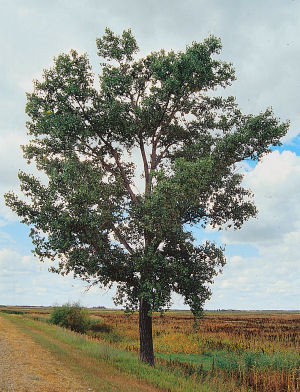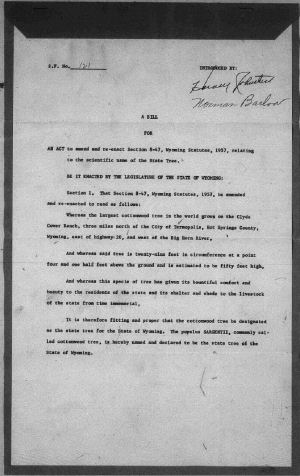
HOME
INTRO
SYMBOLS
ALMANAC
ECONOMY
GEOGRAPHY
STATE MAPS
PEOPLE
FORUM
NEWS
COOL SCHOOLS
STATE QUIZ
STATE LINKS
BOOK STORE
MARKETPLACE
GUESTBOOK
CONTACT US


You may double left-click on a word on this page to retrieve its definition. Tweet Follow
Wyoming State Tree

Wyoming State Tree: Cottonwood Tree
The inspiration for proposing the cottonwood as the official state tree of Wyoming came from a specimen found north of Thermopolis on the ranch of Paul Klein, originally the J. M. Cover homestead. This tree, the largest in the United States and thought to be the "largest cottonwood tree in the world," about 50 or 55 feet tall, measured 29 feet around. *
Fast growing and relatively short-lived, cottonwoods thrive throughout the state of Wyoming.
Legislative activity to declare the cottonwood Wyoming's official state tree began on January 18, 1947 when State Representative Ken Byerly introduced House Bill No. 15 to the legislature. House Bill No. 15 specifically named the cottonwood species Populus balsamifera.
It wasn't just that Wyoming was home to the "largest cottonwood tree in the world" that made the cottonwood such a desirable selection to represent the state.
As stated by House Bill No. 15, the tree also provided "bountiful comfort and beauty" to generations of Wyomingites and, further, "shelter and shade" to livestock.
It bears emphasis. The cottonwood tree was described to have provided these services "from time immemorial." Quite a statement!
H. B. No. 15 Introduced by: Ken Byerly
A BILL
for
AN ACT to designate the Cottonwood tree as the State tree for the State of Wyoming.
BE IT ENACTED BY THE LEGISLATURE OF THE STATE OF WYOMING;
Section 1. Whereas the largest Cottonwood tree in the world grows on The Clyde Cover ranch, three miles north of the city of Thermopolis, Hot Springs County, Wyoming, east of Highway 20, and west of the Big Horn River,
And whereas said tree is twenty-nine feet in circumference at a point four and one half feet above the ground and is estimated to be fifty feet high,
And whereas this specie of tree has given its bountiful comfort and beauty to the residents of the State and its shelter and shade to the livestock of the State from time immemorial,
IT IS THEREFORE fitting and proper that the Cottonwood tree be designated as the State tree for the State of Wyoming.
Section 2. The Populus Balsamifera, commonly called Cottonwood tree, is hereby named and declared to be the State tree of the State of Wyoming.

1961 Wyoming Senate File No. 121
In a quick nine days after introduction, on January 27, 1947, Rep. Byerly's bill was approved (56-0) by the House of Representatives and forwarded to the Senate for consideration.
The Wyoming Senate wasted no time either and approved the state tree bill in a mere five days. On January 31, 1947, the Senate also passed (19-6) House Bill No. 15.
The cottonwood tree, Populus balsamifera, was made the official state tree of Wyoming when Governor Lester C. Hunt signed House Bill No. 15 on February 1, 1947.
Like all living things, there is a season, and the season for the "largest cottonwood tree in the world" ended in fire on May 1, 1955 after being struck by lightning.
The state tree designation was re-visited fourteen years after being honored when it was determined that the cottonwood species specified in 1947's House Bill No. 15 was not the intended recipient of the official status. The bill incorrectly identified Populus balsamifera rather than the intended Populus sargentii.
On January 21, 1961, Senate File No. 121 was introduced by Senators Harvey Johnston and Norman Barlow to correct the scientific name of the official state tree in the Wyoming statutes. The legislation proposed to change the designation from Populus balsamifera to Populus sargentii.
S. F. No. 121
Introduced by: Harvey Johnston
Norman BarlowA BILL
for
AN ACT to amend and re-enact Section 8-47, Wyoming Statutes, 1957, relating to the scientific name of the State Tree.
BE IT ENACTED BY THE LEGISLATURE OF THE STATE OF WYOMING:
Section 1. That Section 8-47, Wyoming Statutes, 1957, be amended and re-enacted to read as follows:
Whereas the largest cottonwood tree in the world grows on the Clyde Cover Ranch, three miles north of the City of Thermopolis, Hot Springs County, Wyoming, east of highway 20, and west of the Big Horn River,
And whereas said tree is twenty-nine feet in circumference at a point four and one half feet above the ground and is estimated to be fifty feet high,
And whereas this species of tree has given its bountiful comfort and beauty to the residents of the states and its shelter and shade to the livestock of the state since time immemorial,
It is therefore fitting and proper that the cottonwood tree be designated as the state tree for the State of Wyoming. The Populus SARGENTII, commonly called the cottonwood tree, is hereby named and declared to be the state tree of the State of Wyoming.
The corrective measure was approved in the Senate and the House of Representatives and subsequently signed by Governor Jack R. Gage on February 24, 1961, effectively changing Wyoming's official state tree from Populus balsamifera to Populus sargentii.
Some perhaps irrelevant thoughts about the scientific name change
The common usage name, "cottonwood," could refer to any number of similar cottonwood species growing in Wyoming.
The original 1947 designation referred to the "cottonwood" tree, Populus balsamifera. By including the scientific name, Populus balsamifera in the legislation, Wyoming legislators declared one particular species of cottonwood as the official state tree.
Populus balsamifera is known by many common or local names such as balsam poplar, bam, bamtree, eastern balsam-poplar, hackmatack, tacamahac poplar, tacamahaca and, yes, even "cottonwood." The growth range of Populus balsamifera does include Wyoming, so Populus balsamifera could have been the intended tree at the time of the 1947 legislation, yet, the legislation does not include any of these common names but falls back on the more general "cottonwood."
In 1961, the approval of House Bill No. 121 made a very specific change to the original 1947 legislation. It changed the scientific reference to the state tree from Populus balsamifera to Populus sargentii. This legislation changes the state tree designation from one specific species to another.
Like Populus balsamifera, Populus sargentii also grows in Wyoming and is, in this regard, a fitting selection for state tree. Common usage names for Populus sargentii include plains cottonwood and, again, "cottonwood."
The 1961 legislation was referred to as "corrective legislation." This terminology seems to make it clear that the original 1947 legislation intended to name Populus sargentii the official state tree, but just got it wrong when they approved the bill that named Populus balsamifera the state tree.
We wonder why the 1961 legislation did not attempt to make more specific the common usage, perhaps by changing "cottonwood" to "plains cottonwood."
Relevant thoughts about the scientific name
To add to our confusion, we often see the Wyoming state tree referred to as Populus deltoides or Populus deltoides ssp. monilifera though this is contrary to the 1961 legislation.
The Populus deltoides reference comes about because of disagreement among botanists about how to classify certain "cottonwoods."
It appears that the current consensus on this favors Populus deltoides ssp. monilifera as the proper classification for the plains cottonwood. This classification defines the plains cottonwood not as a species Populus sargentii but as a sub-species of the eastern cottonwood, Populus deltoides.
We'll leave it at that.
The State of Kansas declared the cottonwood to be their official state tree ten years before Wyoming in 1937.
In 1972, the State of Nebraska also adopted the cottonwood as their official state tree.
* Some sources have listed the height of the Klein ranch tree at 76 feet, 11 inches.
Wyoming Law
The following information was excerpted from the Wyoming Statutes, Title 8, Chapter 3, Section 8-3-106.
Title 8 General Provisions
Chapter 3 State Seal, Flag, Flower, Bird and Other Symbols
Wyo. Stat. § 8-3-106 (2015)
§ 8-3-106. State tree.
The Populus Sargentii [sic] commonly called cottonwood tree, is the state tree of Wyoming.
HISTORY: Laws 1947, ch. 9, §§ 1, 2; W.S. 1957, § 8-47; Laws 1961, ch. 194, § 1; W.S. 1977, § 8-5-105; Laws 1978, ch. 37, § 1.
Sources...
Byerly, Ken. 1947 House Bill No. 15. Cheyenne: Wyoming State Library, 9 Aug. 2012. PDF.
"Cottonwood Is Wyo. Most Common Tree." The News Letter Journal [Newcastle] 11 Sept. 1947: 3. Print.
Johnston, Harvey, and Norman Barlow. 1961 Senate File No. 121. Cheyenne: Wyoming State Library, 9 Aug. 2012. PDF.
"Plains Cottonwood - Populus Sargentii." Wyoming Secretary of State. State of Wyoming, n.d. Web. 10 Jan. 2015.
Shearer, Benjamin F. and Barbara S. State Names, Seals, Flags and Symbols: A Historical Guide Third Edition, Revised and Expanded. Westport, Conn: Greenwood Press, 3 Sub edition, 2001.
"Wyoming Statutes." Wyoming State Legislature. State of Wyoming, n.d. Web. 21 Nov. 2016.
Additional Information
Cottonwood: Great Plains Nature Center.
Plains Cottonwood: Article by Stuart Wier.
Cottonwoods -- Choosing and Important Facts :
Garden Tips from the Cheyenne Botanic Gardens.
:
Garden Tips from the Cheyenne Botanic Gardens.
Website: Cheyenne Botanic Gardens.
Populus deltoides W. Bartram ex Marshall (eastern cottonwood): USDA, NRCS. 2016. The PLANTS Database (http://plants.usda.gov). National Plant Data Center, Baton Rouge, LA 70874-4490 USA.
Populus sargentii Dode: Integrated Taxonomic Information System (ITIS).
Populus sargentii: Search for images of Populus sargentii with Google.
State trees: Complete list of official state trees from NETSTATE.COM.
More symbols & emblems: Complete list of official Wyoming state symbols from NETSTATE.COM.

